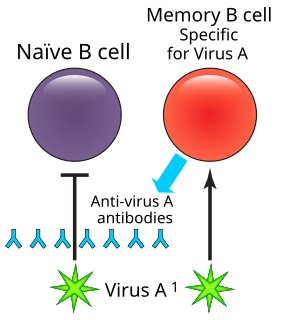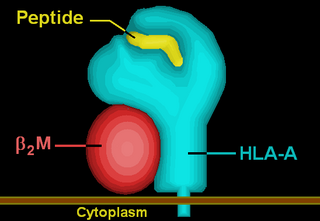
A cytotoxic T cell is a T lymphocyte that kills cancer cells, cells that are infected, or cells that are damaged in other ways.

Proteus is a genus of Gram-negative Proteobacteria. Proteus bacilli are widely distributed in nature as saprophytes, being found in decomposing animal matter, sewage, manure soil, the mammalian intestine, and human and animal feces. They are opportunistic pathogens, commonly responsible for urinary and septic infections, often nosocomial.

Memory B cells are a B cell sub-type that are formed within germinal centers following primary infection and are important in generating an accelerated and more robust antibody-mediated immune response in the case of re-infection.

The adaptive immune system, also known as the acquired immune system or, more rarely, as the specific immune system, is a subsystem of the overall immune system that is composed of highly specialized, systemic cells and processes that eliminate pathogens or prevent their growth. The acquired immune system is one of the two main immunity strategies found in vertebrates. Acquired immunity creates immunological memory after an initial response to a specific pathogen, and leads to an enhanced response to subsequent encounters with that pathogen. This process of acquired immunity is the basis of vaccination. Like the innate system, the acquired system includes both humoral immunity components and cell-mediated immunity components.
In immunology, affinity maturation is the process by which Tfh cell-activated B cells produce antibodies with increased affinity for antigen during the course of an immune response. With repeated exposures to the same antigen, a host will produce antibodies of successively greater affinities. A secondary response can elicit antibodies with several fold greater affinity than in a primary response. Affinity maturation primarily occurs on surface immunoglobulin of germinal center B cells and as a direct result of somatic hypermutation (SHM) and selection by Tfh cells.

The T-cell receptor, or TCR, is a molecule found on the surface of T cells, or T lymphocytes, that is responsible for recognizing fragments of antigen as peptides bound to major histocompatibility complex (MHC) molecules. The binding between TCR and antigen peptides is of relatively low affinity and is degenerate: that is, many TCRs recognize the same antigen peptide and many antigen peptides are recognized by the same TCR.
Central tolerance, also known as negative selection, is the process of eliminating any developing T or B lymphocytes that are reactive to self. Through elimination of autoreactive lymphocytes, tolerance ensures that the immune system does not attack self peptides. Lymphocyte maturation occurs in primary lymphoid organs such as the bone marrow and the thymus. In mammals, B cells mature in the bone marrow and T cells mature in the thymus.

Germinal centers or germinal centres (GCs) are sites within secondary lymphoid organs – lymph nodes and the spleen where mature B cells proliferate, differentiate, and mutate their antibody genes, and switch the class of their antibodies during a normal immune response to an infection. These develop dynamically after the activation of follicular B cells by T-dependent antigen.

In immunology, an idiotype is a shared characteristic between a group of immunoglobulin or T cell receptor (TCR) molecules based upon the antigen binding specificity and therefore structure of their variable region. The variable region of antigen receptors of T cells (TCRs) and B cells (immunoglobulins) contain complementarity determining regions (CDRs) with unique amino acid sequences. They define the surface and properties of the variable region, determining the antigen specificity and therefore the idiotope of the molecule. Immunoglobulins or TCRs with a shared idiotope are the same idiotype. Antibody idiotype is determined by:
CD58, or lymphocyte function-associated antigen 3 (LFA-3), is a cell adhesion molecule expressed on Antigen Presenting Cells (APC), particularly macrophages.

HLA-A23 (A23) is a human leukocyte antigen serotype within HLA-A serotype group. The serotype is determined by the antibody recognition of α23 subset of HLA-A α-chains. For A23, the alpha, "A", chain are encoded by the HLA-A*23 allele group and the β-chain are encoded by B2M locus. This group currently is dominated by A*2301. A23 and A*23 are almost synonymous in meaning. A23 is a split antigen of the broad antigen HLA-A9 and it is a sister serotype of HLA-A24.

HLA-A25 (A25) is a human leukocyte antigen serotype within HLA-A serotype group. The serotype is determined by the antibody recognition of α25 subset of HLA-A α-chains. For A25, the alpha "A" chain are encoded by the HLA-A*25 allele group and the β-chain are encoded by B2M locus. This group currently is dominated by A*2501. A25 and A*25 are almost synonymous in meaning. A25 is a split antigen of the broad antigen serotype A10. A25 is a sister serotype of A26, A34, A43, and A66.

HLA-A43 (A43) is a human leukocyte antigen serotype within HLA-A serotype group. The serotype is determined by the antibody recognition of α43 subset of HLA-A α-chains. For A43, the alpha "A" chain are encoded by the HLA-A*43 allele group and the β-chain are encoded by B2M locus. This group currently is dominated by A*4301. A43 and A*43 are almost synonymous in meaning. A43 is a split antigen of the broad antigen serotype A10. A43 is a sister serotype of A25, A26, A34, and A66.

HLA-A66 (A66) is a human leukocyte antigen serotype within HLA-A serotype group. The serotype is determined by the antibody recognition of α66 subset of HLA-A α-chains. For A66, the alpha "A" chain are encoded by the HLA-A*66 allele group and the β-chain are encoded by B2M locus. A66 and A*66 are almost synonymous in meaning. A66 is a split antigen of the broad antigen serotype A10. A66 is a sister serotype of A25, A26, A34, and A43.

HLA-A74 (A74) is a human leukocyte antigen serotype within HLA-A serotype group. The serotype is determined by the antibody recognition of α74 subset of HLA-A α-chains. For A74, the alpha "A" chain are encoded by the HLA-A*74 allele group and the β-chain are encoded by B2M locus. A74 and A*74 are almost synonymous in meaning. A74 is a split antigen of the broad antigen serotype A19. A74 is a sister serotype of A29, A30, A31, A32, and A33.

HLA-A31 (A31) is a human leukocyte antigen serotype within HLA-A serotype group. The serotype is determined by the antibody recognition of α31 subset of HLA-A α-chains. For A31, the alpha "A" chain are encoded by the HLA-A*31 allele group and the β-chain are encoded by B2M locus. This group currently is dominated by A*3101. A31 and A*31 are almost synonymous in meaning. A31 is a split antigen of the broad antigen serotype A19. A31 is a sister serotype of A29, A30, A32, A33, and A74.

HLA-A29 (A29) is a human leukocyte antigen serotype within HLA-A serotype group. The serotype is determined by the antibody recognition of α29 subset of HLA-A α-chains. For A29, the alpha "A" chain are encoded by the HLA-A*29 allele group and the β-chain are encoded by B2M locus. This group currently is dominated by A*2902. A29 and A*29 are almost synonymous in meaning. A29 is a split antigen of the broad antigen serotype A19. A29 is a sister serotype of A30, A31, A32, A33, and A74.

HLA-A30 (A30) is a human leukocyte antigen serotype within HLA-A serotype group. The serotype is determined by the antibody recognition of α30 subset of HLA-A α-chains. For A30, the alpha "A" chain are encoded by the HLA-A*30 allele group and the β-chain are encoded by B2M locus. A30 and A*30 are almost synonymous in meaning. A30 is a split antigen of the broad antigen serotype A19. A30 is a sister serotype of A29, A31, A32, A33, and A74.
Somatic hypermutation is a cellular mechanism by which the immune system adapts to the new foreign elements that confront it, as seen during class switching. A major component of the process of affinity maturation, SHM diversifies B cell receptors used to recognize foreign elements (antigens) and allows the immune system to adapt its response to new threats during the lifetime of an organism. Somatic hypermutation involves a programmed process of mutation affecting the variable regions of immunoglobulin genes. Unlike germline mutation, SHM affects only an organism's individual immune cells, and the mutations are not transmitted to the organism's offspring. Mistargeted somatic hypermutation is a likely mechanism in the development of B-cell lymphomas and many other cancers.








